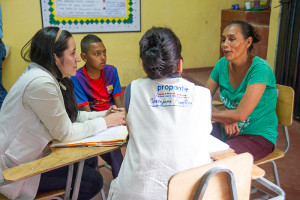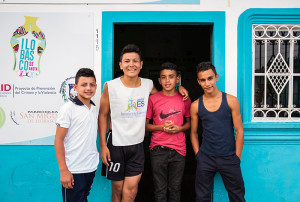[vc_row][vc_column][vc_column_text]
Rethinking youth risk & response in Central America
By Jillian Slutzker
[/vc_column_text][/vc_column][/vc_row][vc_row][vc_column width=”2/3″][vc_column_text]In high violence neighborhoods across Central America, educators face bigger challenges than preparing lessons and keeping students in school. With gang life permeating communities, the school environment is no exception and teachers may be subject to threats, extortion and fear.
“A threatened cop cannot protect a neighborhood, and it is very hard for a threatened teacher to be able to teach,” said Guillermo Cespedes, Senior Citizen Security Advisor at Creative Associates International and former Deputy Mayor of Los Angles for Gang Reduction and Youth Development, speaking at the 2015 USAID Global Education Summit on Nov. 4 in Silver Spring, Md.
In these high-violence environments, said Cespedes, responding to the educational needs of at-risk youth is nearly impossible without also including contextualized, targeted violence reduction strategies in what he calls a “braided,” multi-sectoral approach.
“Effective education requires mastery of content and mastery of the context,” he said.
The context Cespedes is referring to is one in which homicide rates can climb into the triple digits—for example, reaching 113 homicides per 100,000 in El Salvador in August. In some of the hardest hit areas, murder rates may be three-fold rates in other parts of the country.
Focusing on these hotspot neighborhoods and understanding the gang relational networks and levels of risk faced by different youth, educators and families is critical for successful programs across sectors.
Creative has supported high risk communities across Central America in developing and implementing local violence prevention strategies. Through Creative’s more than 200 Outreach Centers, more than 55,000 at-risk youth in the most challenging neighborhoods in El Salvador, Guatemala, Honduras and Panama have benefited from vocational training, life skills, tutoring support, and access to a safe place away from the violence.
Relationships matter in a ‘silent’ war
To understand the high violence contexts of Central America, Cespedes said, development practitioners need to move beyond the term “gang” and considered the reaches of gang influence—potentially thousands of mothers, siblings, girlfriends and others associated with gang members.
“The term gang is a law enforcement term. It doesn’t really tell you the relational networks that are involved,” said Cespedes. “The actual relational network is much much larger.”
These networks have permeated the boundaries of family and school, Cespedes explained, and within them there exists an unspoken code of silence. To cautioning a family member, friend or student against gang affiliation or to discuss a particular homicide and its perpetrators is to risk retaliation or extortion. The result is a widespread paralysis across a community while violence continues.
“It’s like being in a war, but it’s a silent war,” said Cespedes. “No one talks about who shot who.”
Moving from criminal justice to social identity
To break this paralysis and better respond to gang violence and youth at risk of joining gangs, Cespedes said development practitioners and governments should first stop using a criminal justice lens that views gang members themselves as the problem.
Instead, he said, we should look at gang-related activity as the problem and view gang membership through a social identity lens, wherein an at-risk youth seeks out a gang identity in what Cespedes calls a “recruitment and auditioning cycle.”
From the ages of 10 to 15, youth search for an identity and connections outside the family—a completely normal developmental stage. But kids without a sense of connection to a family structure are particularly vulnerable to joining a gang in this time, said Cespedes. The gang can provide that sense of identity.
“It’s not just the gang looking for kids, it’s the kids looking for gangs,” he said.
Viewing gangs in terms of social identity and aiming to reduce factors that cause youth to join would expand the tools and approaches available to practitioners beyond law enforcement alone.
“It is very difficult to blend criminal justice approaches with economic growth or with education,” said Cespedes, noting that locking up gang members often backfires and strengthens gang identity.
But by focusing on changing a youth’s behavior rather than criminalizing his/her identity, Cespedes said we can reduce violence and keep families, communities and schools safer.
It is this shift in focus and approach that helped the city of LA reduce nine different categories of gang-related crime by nearly 50 percent.
From 2009 to 2014, Cespedes led the city’s transformative gang violence reduction strategy, which reoriented law enforcement toward community-based policing and constitutional arrests and blended it with a tapestry of social programs.
Reaching the right kids with the right medicine

Hundreds of thousands of kids live in high violence neighborhoods across Central America, but only a very small minority is likely to seek out a gang identity—a critical distinction for designing programs that reach the right youth, said Cespedes.
Those youth most at risk of joining a gang can be identified using the Youth Service Eligibility Tool—a method developed in Los Angeles to evaluate youth on a series of nine risk factors which account for individual, family and peer dimensions. If a youth presents four or more risk factors—including things like family gang affiliation, peer delinquency, impulsive risk taking and more—then he/she is considered high risk.
Cespedes and his team have piloted the tool in Mexico, El Salvador and Honduras.
For these high-risk youth falling into this “secondary prevention” level, Cespedes calls for individualized interventions that involve regular meetings between counselors, families and at-risk youth over a year period.
“This approach requires expanding the view of family. The Central American family is no longer mom, dad, two kids and a white picket fence and a cat,” he said, as transnational migration means that parents are often overseas, and guardians may be uncles, siblings and grandparents.
These regular meetings reduce youth risk factors by helping youth develop problem-solving strategies and build on positive assets and connections among his/her relatives and support system.
“The diagnosis, like a lot of diagnoses, is about pathology but the intervention has to be asset based,” Cespedes noted. “You aren’t going to get families to cooperate if you focus on what’s missing instead of what’s there.”
In Creative’s Honduras pilot of the secondary prevention program, called Proponte, this approach reduced youth risk factors significantly at the end of the one year period—including a 77 percent drop in the crime and substance abuse risk factor and a 78 percent drop in antisocial tendencies.
Four levels of risk

Cespedes said this secondary prevention work must go hand-in-hand with three other “legs of the table”—primary prevention for the general youth population in high risk areas, tertiary prevention and reentry for youth actively involved in criminal groups, and law enforcement.
“Some youth need to be arrested. They need a time out,” said Cespedes. “But the medicine of placing a youth in a penal institution also has negative side effects, so we need to be thoughtful about who can benefit from a less toxic medicine so we help that youth while protecting the community.”
With different youth facing different risk levels and requiring tailored responses, there is no single thing a community can do to lower violence levels, said Cespedes, “it is a series of things.”
This four-pronged intervention, said Cespedes, is also most effective when coordinated in a very concentrated high-violence area.
“Violence is a national problem but it requires a very local solution,” he said.
Gang violence reduction interventions in Los Angeles, for example, took place in an area less than four square miles.
Unanswered questions for education
Despite empirical information on what risk factors drive youth to seek out gang identity and clear data on how targeted secondary prevention can help reduce those, Cespedes said there remain unanswered questions on how the education sector can and should respond.
“How do we develop educational programs for each one of these levels?” he posited. “Should programming look different for each one of these levels of risk?”
A lack of access to education is also a challenge in the Central American context, where the number of schools drops off sharply from middle to high school, the age when young people are most at risk.
“At a time when we most need a partnership between violence reduction work and schools, it’s the absence of,” he said. “It’s particular at this age, we need to circle the wagons around that youth. It’s a critical transition point.”
Moving forward, said Cespedes, will require a multi-sectoral approach with the goals of securing safe passage for students and teachers, blending educational approaches with reducing gang risk factors and strengthening student, family, teacher relationships.
“We need to figure out what we do educationally and what we do in relation to violence reduction and whether that intervention should include the family and the teacher.”[/vc_column_text][/vc_column][vc_column width=”1/12″][/vc_column][vc_column width=”1/4″][vc_widget_sidebar sidebar_id=”sidebar-primary”][/vc_column][/vc_row]